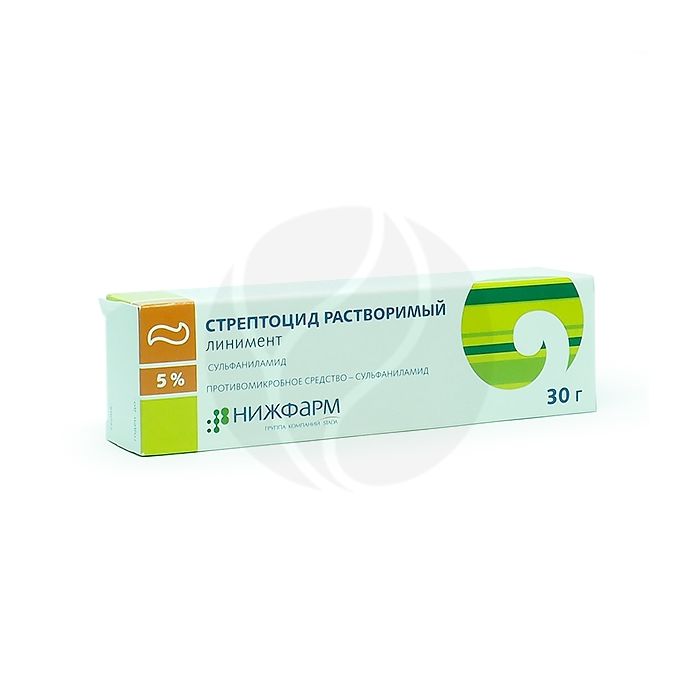Streptocide soluble liniment 5%, 30 g
Russian Pharmacy name:
Стрептоцид растворимый линимент 5%, 30 г
Infected wounds of various etiologies,
burns (I-II century),
folliculitis,
boils,
carbuncles,
acne vulgaris,
impetigo,
erysipelas and other purulent-inflammatory skin processes.
Outwardly. Liniment is applied to a gauze bandage, which is applied to the affected area; dressings are made in 1-2 days.
With a large lesion area, the daily dose of liniment in terms of sulfanilamide should not exceed 6 g in adults (corresponds to 120 g of liniment), 0.6 g in children under 1 year of age (corresponds to 12 g of liniment), 1.8 g in children 1-5 years (corresponds to 36 g of liniment), 3 g in children 5-12 years old (corresponds to 60 g of liniment).
1 g of liniment contains:
active substance - sodium sulfonamide (soluble streptocide) - 0.05 g (in terms of 100% substance);
excipients: glycerol (distilled glycerin) - 0.30 g, emulsifier No. 1 (LanetteЃ SX) - 0.080 g, water (purified water) - up to 1 g.
Hypersensitivity to drug components,
anemia,
renal / hepatic impairment,
congenital deficiency of glucose-6-phosphate dehydrogenase,
azotemia,
porphyria,
pregnancy,
lactation period.
Carefully
Children's age up to 3 months.
Composition
1 g of liniment contains:
active substance - sodium sulfonamide (soluble streptocide) - 0.05 g (in terms of 100% substance);
excipients: glycerol (distilled glycerin) - 0.30 g, emulsifier No. 1 (LanetteЃ SX) - 0.080 g, water (purified water) - up to 1 g.
Description
Liniment, white or white with a creamy shade, with a specific odor.
Pharmacotherapeutic group
Antimicrobial agent - sulfonamide
Pharmacological properties
Antimicrobial bacteriostatic agent, sulfonamide. The mechanism of action of the drug is due to competitive antagonism with para-aminobenzoic acid (PABA), inhibition of dihydropteroate synthase, disruption of the synthesis of tetrahydrofolic acid, which is necessary for the synthesis of purines and pyrimidines. Active against Staphylococcus spp., Streptococcus spp., Including S. pyagenes, S. pneumoniae, Legionella spp., Brucella spp., Escherichia coli, Shigella spp., Klebsiella spp., Proteus spp., Salmonella spp., Serratia spp., Calymmatobacterium granulomatis, Vibrio cholerae, Clostridium perfringens, Bacillus anthracis, Nocardia asteroids, Corynebacterium diphtheriae, Yersinia pestis, Chlamydia spp., Actinomyces israelii, Toxoplasma gondii.
When applied to the skin, it promotes rapid healing of wounds and epithelialization of erosions.
Indications for use
Infected wounds of various etiologies,
burns (I-II century),
folliculitis,
boils,
carbuncles,
acne vulgaris,
impetigo,
erysipelas and other purulent-inflammatory skin processes.
Contraindications
Hypersensitivity to drug components,
anemia,
renal / hepatic impairment,
congenital deficiency of glucose-6-phosphate dehydrogenase,
azotemia,
porphyria,
pregnancy,
lactation period.
Carefully
Children's age up to 3 months.
Method of administration and dosage
Outwardly. Liniment is applied to a gauze bandage, which is applied to the affected area; dressings are made in 1-2 days.
With a large lesion area, the daily dose of liniment in terms of sulfanilamide should not exceed 6 g in adults (corresponds to 120 g of liniment), 0.6 g in children under 1 year of age (corresponds to 12 g of liniment), 1.8 g in children 1-5 years (corresponds to 36 g of liniment), 3 g in children 5-12 years old (corresponds to 60 g of liniment).
Side effect
Allergic reactions are possible. With prolonged use of large doses - systemic action: headache, nausea, vomiting, dyspepsia, leukopenia, agranulocytosis, crystalluria.
Overdose
No cases of drug overdose have been reported.
Interaction with other medicinal products
Myelotoxic drugs increase the manifestations of the drug's hematotoxicity.
special instructions
When treating extensive skin lesions, drink plenty of alkaline water.
Influence on the ability to drive vehicles and work with mechanisms
The drug does not affect the ability to drive vehicles and engage in potentially hazardous activities that require increased concentration of attention and speed of psychomotor reactions.
Release form
Liniment 5%.
30 g each in aluminum tubes or polyethylene laminate tubes. Each tube, along with instructions for medical use of the drug, is placed in a cardboard box.
Storage conditions
At a temperature not higher than 25 ? C.
Keep out of the reach of children.
Shelf life
4 years. Do not use the drug after the expiration date printed on the package.
Vacation conditions
Without recipe.

